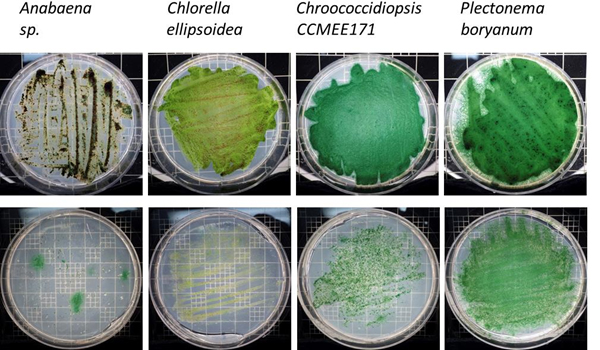Engineering Algae for Mars
The ultimate goal of Mars exploration is to send humans there, possibly permanently. If we’re going to manage this, we’ll need ways to generate breathable oxygen from an atmosphere that is 95% carbon dioxide. Check out our blog if you want to read more about why Mars exploration is important.
Cyanobacteria are the only reason we have oxygen to breathe on Earth. They evolved photosynthesis; with just sunlight and carbon dixoide, they generated the our life-sustaining atmosphere. They live just about everywhere, even in such harsh environments as the interior of Antarctica.
Mars Simulator Environmental Cabinet
Image courtesy of TechShot, Inc.
Previous research by TechShot, Inc has shown that some cyanobacteria can survive the Mars-like conditions of their Mars
Goals:The primary goal of this project is to discover the basic conditions that a photosynthetic organism requires to grow and to identify the phenotypic characteristics and underlying genes that are critical for adapting to an alternate environment. Our goal is to use Mars as the comparative environment to Earth, and assess the survivability and adaptability of one of Earth's simplest photosynthetic organisms, cyanobacteria. Cyanobacteria are photosynthetic bacteria that fix carbon and generate oxygen from CO2 and sunlight. Ancient relatives of extant cyanobacteria were responsible for the generation of an oxygenated atmosphere on Earth, and they currently produce about a quarter of the O2 in the atmosphere. Importantly, cyanobacteria can thrive in high CO2 environments similar to a Martian atmosphere.
Methodology:
We will identify genes related to adaption to Mars-like conditions using a random-barcoded transposon (RB-TnSeq) library in the genetic model cyanobacterium Synechococcus elongatus PCC 7942. After the library is grown under varied environmental conditions, the transposon sequencing will be used to identify genes that provide survival benefits or liabilities in the tested Mars-like environments. For instance, we have already subjected the RB-TnSeq library to growth under cold conditions, and discovered several genes that when mutated confer a survival advantage. Our project would aim to perform separate experiments with appropriate controls, modifying a single environmental parameter for each. This will allow the identification of the greatest number of phenotypes responsible for adaptation to each condition, to test combinations of parameters to determine which are flexible and which stringent, and identify sets of genes most likely to be required for survivability and growth in a habitat on Mars.
These candidate genes will be validated by site-directed mutation, and then can be combined to generate strains better adapted to the Martian surface or constructed habitats. Our laboratory's expertise and the CYANO-VECTOR cyanobacterial genetic engineering platform we have developed make us well-qualified to achieve the goals of the proposed research.
One of the inherent benefits of this proposal is that it utilizes equipment already developed by prior NASA grant programs. As part of a NASA Innovative Advanced Concepts (NIAC) grant, Indiana-based TechShot has developed a Mars simulation chamber, capable of fully mimicking conditions on the Martian surface. This chamber replicates the Martian insolation, temperature, and atmospheric composition and pressure, and can be maintained for long duration experiments. In initial testing, the TechShot investigators determined that several strains of cyanobacteria were able to successfully grow under the conditions in their test chamber. However, funding was not extended for a phase II program, and the simulation chamber is currently dormant. TechShot's chief scientific officer, Dr. Eugene Boland, has assured us of his desire to see the chamber in use for future experiments should a subsequent grant receive funding.





